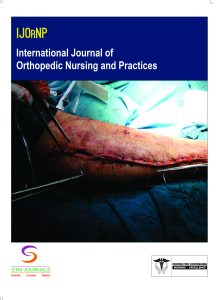
Zaina Jose Elizabeth,

Regina P.F.,

Rose Jose,
- Professor Nehru College of Nursing Kerala India
- Associate Professor Nehru College of Nursing Kerala India
- Assistant Professor Nehru College of Nursing Kerala India
Abstract
Carpal tunnel syndrome (CTS) is a prevalent and concerning issue affecting the wrist and hand, arising from the compression of the median nerve within the carpal tunnel. This compression results in a spectrum of distressing symptoms, including numbness, tingling, weakness, and discomfort, particularly in the thumb, index, and middle fingers. Despite its frequent association with repetitive hand movements and prolonged use of computers or handheld devices, CTS can stem from various factors, encompassing genetic predisposition, underlying health conditions, and occupational risks. The abstract aims to delve into the management of CTS, offering insights into its symptoms and potential relief strategies. Prompt recognition and comprehension of symptoms are crucial for effectively managing this syndrome. Diagnostic measures, including clinical assessments and nerve conduction studies, aid in confirming the diagnosis and initiating appropriate interventions. Therapeutic approaches for managing CTS span a spectrum from conservative to surgical measures, depending on the severity of symptoms and the patient’s condition. Non-invasive methods such as wrist splinting, ergonomic adjustments, and lifestyle modifications often provide initial relief. Additionally, physical therapy and targeted exercises aim to alleviate discomfort and enhance wrist flexibility and strength. In cases refractory to conservative treatments, surgical interventions like carpal tunnel release may be considered to alleviate pressure on the median nerve, thereby mitigating symptoms and restoring hand function. This abstract strives to provide a comprehensive understanding of CTS management, emphasizing the importance of early recognition, lifestyle modifications, and a multi-disciplinary approach involving healthcare professionals. Educating individuals about preventive measures and ergonomic practices is paramount in minimizing the impact of CTS on daily activities and improving the overall quality of life.
Keywords: Carpal tunnel syndrome, lifestyle modifications, healthcare professionals, quality of life
[This article belongs to International Journal of Orthopedic Nursing and Practices(ijornp)]
References
American Academy of Orthopaedic Surgeons (AAOS). (2023). Carpal Tunnel Syndrome – Clinical Practice Guideline (CPG). [online] American Academy of Orthopaedic Surgeons. Available from: https://www.aaos.org/quality/quality-programs/upper-extremity-programs/carpal-tunnel-syndrome/
Mayo Clinic. (2022). Carpal tunnel syndrome – Diagnosis and treatment. [online] Mayo Clinic. Available from: https://www.mayoclinic.org/diseases-conditions/carpal-tunnel-syndrome/
diagnosis-treatment/drc-20355608
National Institute of Neurological Disorders and Stroke (NINDS). (2023). Carpal Tunnel Syndrome. [online]. U.S. Department of Health and Human Services. National Institutes of Health. Available from: https://www.ninds.nih.gov/sites/default/files/migrate-documents/carpal_tunnel_
pdf.
Hochberg MC, Gravallese EM, Silman AJ, Smolen JS, Weinblatt ME, Weisman MH. Rheumatology. 7th edition. Philadelphia, PA: Elsevier; 2019.
Atroshi I, Gummesson C, Johnsson R, Ornstein E, Ranstam J, Rosén I. Prevalence of carpal tunnel syndrome in a general population. JAMA. 1999;282(2):153–8. doi: 10.1001/jama.282.2.153.
Padua L, Coraci D, Erra C, Pazzaglia C, Paolasso I, Loreti C et al. Carpal tunnel syndrome: clinical features, diagnosis, and management. Lancet Neurol. 2016;15(12):1273–84. doi: 10.1016/S1474-4422(16)30231-9.
Aroori S, Spence RA. Carpal tunnel syndrome. Ulster Med J. 2008 Jan;77(1):6–17.
Atroshi I, Gummesson C, Ornstein E, Johnsson R, Ranstam J. Carpal tunnel syndrome and keyboard use at work: a population-based study. Arthritis Rheum. 2007 Nov;56(11):3620–5. doi: 10.1002/art.22956.
Hou WH, Hsu JH, Lin CH, Liang HW. Carpal tunnel syndrome in male visual display terminal (VDT) workers. Am J Ind Med. 2007 Jan;50(1):1–7. doi: 10.1002/ajim.20396.
Atroshi I, Gummesson C, Johnsson R, Ornstein E. Diagnostic properties of nerve conduction tests in population-based carpal tunnel syndrome. BMC Musculoskelet Disord. 2003 May 7;4:9. doi: 10.1186/1471-2474-4-9.
| Volume | 01 |
| Issue | 02 |
| Received | December 28, 2023 |
| Accepted | December 30, 2023 |
| Published | January 9, 2024 |


